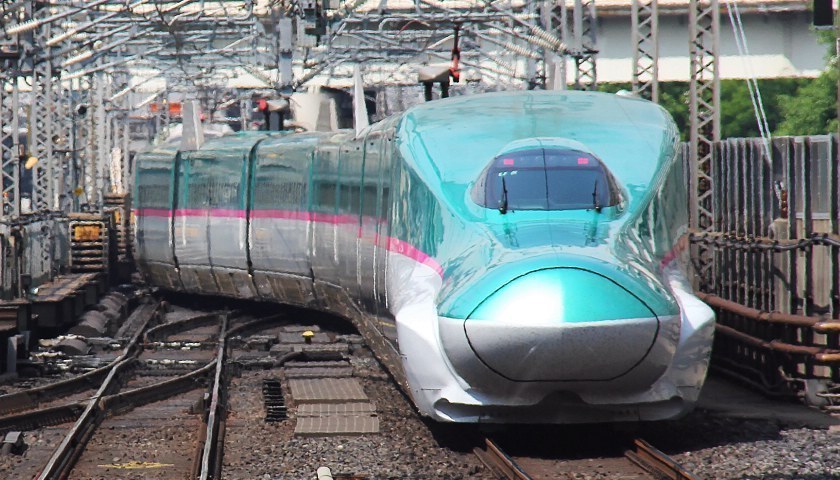Tohoku Shinkansen

The Tohoku Shinkansen (東北新幹線, Tōhoku Shinkansen) is a shinkansen line that connects Tokyo with Aomori at the northern tip of Honshu. It was opened in 1982 and completed to Aomori in 2010. The Tohoku Shinkansen is operated by the East Japan Railway Company, commonly known as JR East.
Two branch lines, the Akita Shinkansen (秋田新幹線) and the Yamagata Shinkansen (山形新幹線), provide shinkansen connections to the prefectures after which they are named. Unlike regular shinkansen lines, these two branch lines use the tracks of existing train lines, employ somewhat narrower train sets and run at lower speeds after branching off from the Tohoku Shinkansen. For these reasons, they are also known as mini-shinkansen.

Six train categories operate on the Tohoku Shinkansen:
The Hayabusa is the fastest train category, serving only the major stations between Tokyo and Shin-Aomori. With speeds of up to 320 km/h, the Hayabusa is the fastest train in Japan. Some Hayabusa continue beyond Shin-Aomori along the Hokkaido Shinkansen to Hakodate. Between Tokyo and Morioka, some trains are coupled with a Komachi train.
The Hayabusa is one of the few shinkansen trains without non-reserved seating. A seat reservation is mandatory. When all seats are booked out, standing tickets can be purchased. Besides ordinary seats (3x2 seats per row) and a Green Car (2x2 seats per row), the Hayabusa carries one Gran Class car, the first class service by JR East with 2x1 seats per row.

The Komachi is the only train category of the Akita Shinkansen. The trains are coupled with Hayabusa trains between Tokyo and Morioka and run on their own between Morioka and Akita. Trains change directions between Akita and Omagari, the last station before Akita.
The Komachi is one of the few shinkansen trains without non-reserved seating. A seat reservation is mandatory. When all seats are booked out, standing tickets can be purchased. Because Komachi trains are narrower than regular shinkansen trains, seating comes in rows of 2x2 seats.

The Yamabiko is the next fastest train category along the Tohoku Shinkansen, running as far north as Morioka, although some terminate at Sendai. Some Yamabiko trains are coupled with a Tsubasa train between Tokyo and Fukushima.

The Tsubasa is the only train category of the Yamagata Shinkansen. Some Tsubasa trains are coupled with a Yamabiko train between Tokyo and Fukushima and run on their own between Fukushima and Shinjo. Some trains terminate at Yamagata Station.
The Tsubasa is one of the few shinkansen trains without non-reserved seating. A seat reservation is mandatory. When all seats are booked out, standing tickets can be purchased. Because Tsubasa trains are narrower than regular shinkansen trains, seating comes in rows of 2x2 seats.

The Nasuno is the slowest train category along the Tohoku Shinkansen, serving all stations between Tokyo and Koriyama and targeting commuters from Fukushima and Tochigi prefectures. Some trains during AM and PM rush hours are fully non-reserved.

Hayate trains used to be numerous in the past, but today only a handful of them are in service, mainly in the early morning or late evening hours.

Note: For simplification, some rare train compositions and stopping patterns are omitted.
Questions? Ask in our forum.